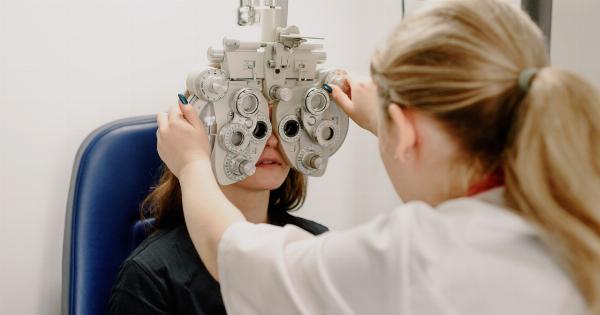The eyes are often referred to as the windows to the soul, but they can also provide important insights into our overall health. In fact, certain eye symptoms can be warning signs of serious ailments, including stroke.
It is crucial to recognize and understand these symptoms so that timely medical intervention can be sought. This article explores some of the eye symptoms that are linked to stroke and other serious health conditions.
1. Sudden Vision Loss
One of the most alarming eye symptoms that can indicate a stroke is sudden vision loss. The loss of vision may affect one or both eyes, and it can be permanent or temporary depending on the severity of the stroke.
Immediate medical attention is necessary in such cases, as vision loss can be a sign of a blockage or rupture of blood vessels that supply the eyes and brain.
2. Blurred Vision
Blurred vision can result from various underlying conditions, including stroke. When a stroke occurs, the blood supply to the eyes and brain is disrupted, leading to a range of visual disturbances.
Blurred vision may be accompanied by other symptoms such as dizziness, weakness, and difficulty speaking. These signs should not be ignored, as they may indicate a severe health issue.
3. Double Vision
Double vision, or diplopia, occurs when the eyes perceive two images instead of one. This condition can be caused by an array of factors, including stroke. Double vision may arise due to damage to the nerves or muscles that control eye movement.
If double vision occurs suddenly and persists, it is crucial to seek immediate medical attention to rule out any serious underlying cause, such as a stroke.
4. Drooping Eyelid
A drooping eyelid, known as ptosis, can be a symptom of stroke and other medical conditions. Ptosis occurs when the muscles responsible for lifting the eyelid become weak or damaged.
In stroke cases, ptosis may develop due to the disruption of nerve signals that control the eyelid muscles. If you experience sudden drooping of one or both eyelids, it is essential to consult a healthcare professional promptly.
5. Painful or Red Eyes
Pain and redness in the eyes can have various causes, including conjunctivitis and dry eye syndrome. However, these symptoms can also be associated with more severe conditions such as stroke.
In some cases, the blood vessels in the eyes may become inflamed or blocked, leading to eye pain and redness. If you experience persistent eye pain along with other stroke symptoms, seek medical attention immediately.
6. Loss of Peripheral Vision
Stroke can impair the visual field, leading to a loss of peripheral vision. Also known as tunnel vision, this condition restricts the field of view, making it difficult to see objects or people at the sides or edges of one’s vision.
Loss of peripheral vision can significantly impact daily activities and increase the risk of accidents. If you notice any changes in your visual field, it is important to undergo a thorough evaluation by a healthcare professional.
7. Eye Twitching
While eye twitching is typically benign and resolves on its own, persistent or recurring twitching can be a sign of a more serious underlying condition. In some cases, excessive eye twitching can be associated with stroke.
The nerve damage caused by a stroke can lead to abnormal muscle contractions, including eyelid twitching. If your eye twitching persists or is accompanied by other concerning symptoms, it is advisable to seek medical guidance.
8. Sensitivity to Light
Sensitivity to light, known as photophobia, can be an indication of various health issues, including stroke. When the brain is affected by a stroke, it can disrupt the processing of visual signals, making the eyes more sensitive to light.
Photophobia can cause discomfort and interfere with daily activities. If you experience heightened sensitivity to light along with other stroke-related symptoms, consult a healthcare professional for an accurate diagnosis.
9. Eye Floaters
Eye floaters are tiny spots or specks that appear to float across one’s field of vision.
While they are usually harmless and commonly occur with age, sudden onset or a sudden increase in the number of floaters can suggest a more serious condition such as a retinal tear or detachment. In some cases, eye floaters may indicate a clot or hemorrhage related to stroke. If you experience a sudden onset of floaters, seek prompt medical attention to rule out any underlying issues.
10. Visual Field Defects
Stroke can result in visual field defects, which refer to the loss of vision in specific areas of the visual field. This can manifest as blind spots, blurred areas, or overall reduced vision in one or both eyes.
Visual field defects can severely impact one’s quality of life and independence. If you notice any changes in your visual field, it is vital to consult an eye specialist or neurologist to determine the underlying cause.
Conclusion
Recognizing the eye symptoms linked to stroke and other serious ailments is crucial for early detection and appropriate medical intervention.
Sudden vision loss, blurred vision, double vision, drooping eyelid, painful or red eyes, loss of peripheral vision, eye twitching, sensitivity to light, eye floaters, and visual field defects are among the symptoms that should never be ignored. If you experience any of these symptoms or are concerned about your eye health, seek immediate medical attention to ensure the best possible outcomes.




























